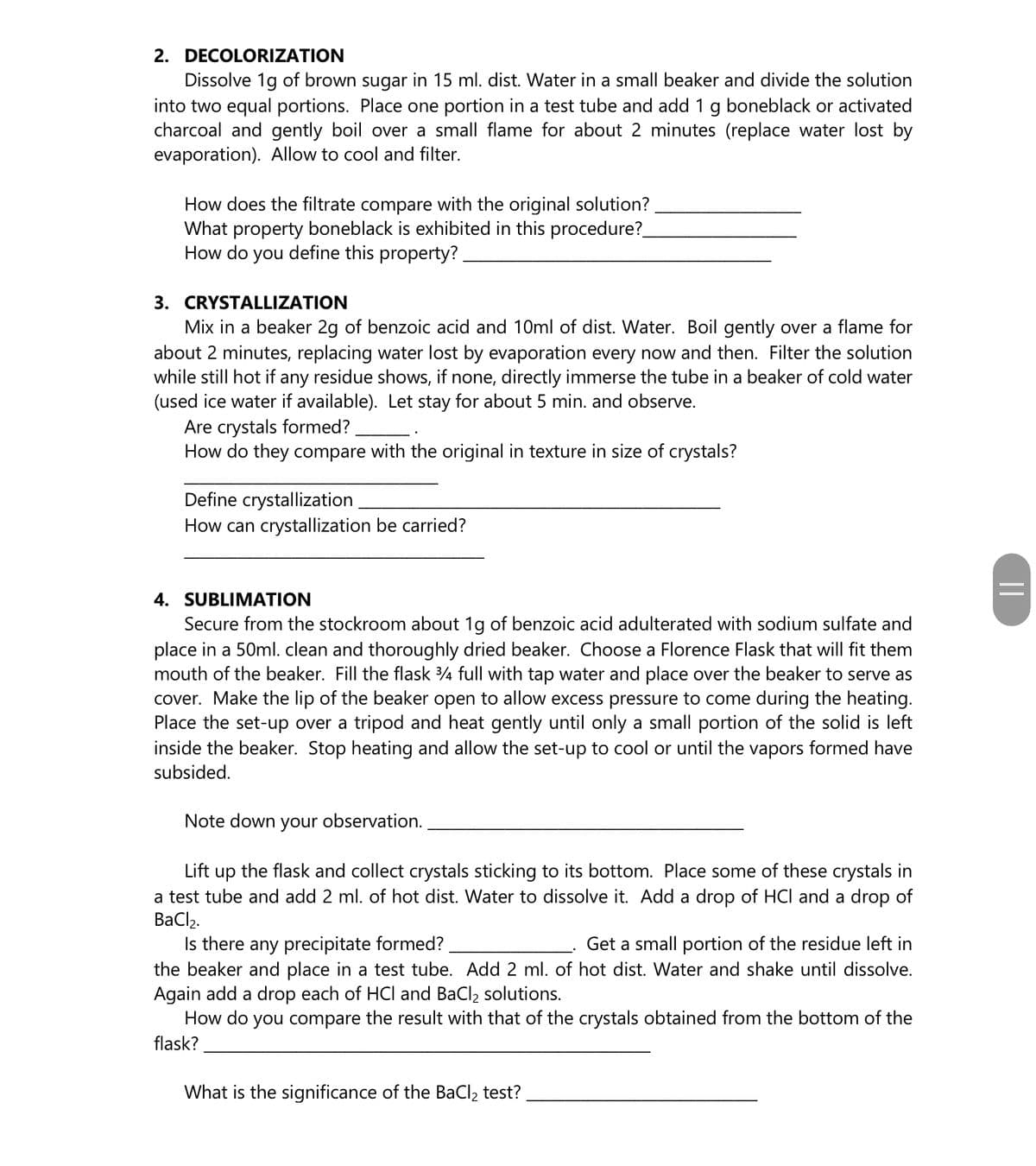2. DECOLORIZATION Dissolve 1g of brown sugar in 15 ml. dist. Water in a small beaker and divide the solution into two equal portions. Place one portion in a test tube and add 1 g boneblack or activated charcoal and gently boil over a small flame for about 2 minutes (replace water lost by evaporation). Allow to cool and filter. How does the filtrate compare with the original solution? What property boneblack is exhibited in this procedure? How do you define this property?
2. DECOLORIZATION Dissolve 1g of brown sugar in 15 ml. dist. Water in a small beaker and divide the solution into two equal portions. Place one portion in a test tube and add 1 g boneblack or activated charcoal and gently boil over a small flame for about 2 minutes (replace water lost by evaporation). Allow to cool and filter. How does the filtrate compare with the original solution? What property boneblack is exhibited in this procedure? How do you define this property?
Basic Clinical Lab Competencies for Respiratory Care: An Integrated Approach
5th Edition
ISBN:9781285244662
Author:White
Publisher:White
Chapter1: Basics Of Asepsis
Section: Chapter Questions
Problem 8SEPT
Related questions
Question

Transcribed Image Text:2. DECOLORIZATION
Dissolve 1g of brown sugar in 15 ml. dist. Water in a small beaker and divide the solution
into two equal portions. Place one portion in a test tube and add 1 g boneblack or activated
charcoal and gently boil over a small flame for about 2 minutes (replace water lost by
evaporation). Allow to cool and filter.
How does the filtrate compare with the original solution?
What property boneblack is exhibited in this procedure?
How do you define this property?
3. CRYSTALLIZATION
Mix in a beaker 2g of benzoic acid and 10ml of dist. Water. Boil gently over a flame for
about 2 minutes, replacing water lost by evaporation every now and then. Filter the solution
while still hot if any residue shows, if none, directly immerse the tube in a beaker of cold water
(used ice water if available). Let stay for about 5 min. and observe.
Are crystals formed?
How do they compare with the original in texture in size of crystals?
Define crystallization
How can crystallization be carried?
4. SUBLIMATION
Secure from the stockroom about 1g of benzoic acid adulterated with sodium sulfate and
place in a 50ml. clean and thoroughly dried beaker. Choose a Florence Flask that will fit them
mouth of the beaker. Fill the flask 4 full with tap water and place over the beaker to serve as
cover. Make the lip of the beaker open to allow excess pressure to come during the heating.
Place the set-up over a tripod and heat gently until only a small portion of the solid is left
inside the beaker. Stop heating and allow the set-up to cool or until the vapors formed have
subsided.
Note down your observation.
Lift up the flask and collect crystals sticking to its bottom. Place some of these crystals in
a test tube and add 2 ml. of hot dist. Water to dissolve it. Add a drop of HCI and a drop of
BaCl2.
Is there any precipitate formed?
the beaker and place in a test tube. Add 2 ml. of hot dist. Water and shake until dissolve.
Again add a drop each of HCl and BaCl2 solutions.
How do you compare the result with that of the crystals obtained from the bottom of the
Get a small portion of the residue left in
flask?
What is the significance of the BaCl, test?
||
Expert Solution
This question has been solved!
Explore an expertly crafted, step-by-step solution for a thorough understanding of key concepts.
This is a popular solution!
Trending now
This is a popular solution!
Step by step
Solved in 3 steps

Recommended textbooks for you

Basic Clinical Lab Competencies for Respiratory C…
Nursing
ISBN:
9781285244662
Author:
White
Publisher:
Cengage

Biology 2e
Biology
ISBN:
9781947172517
Author:
Matthew Douglas, Jung Choi, Mary Ann Clark
Publisher:
OpenStax

Basic Clinical Lab Competencies for Respiratory C…
Nursing
ISBN:
9781285244662
Author:
White
Publisher:
Cengage

Biology 2e
Biology
ISBN:
9781947172517
Author:
Matthew Douglas, Jung Choi, Mary Ann Clark
Publisher:
OpenStax